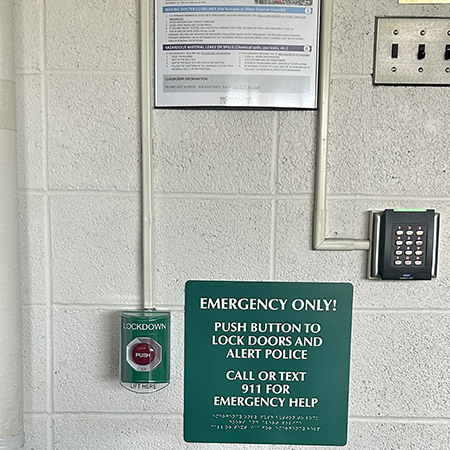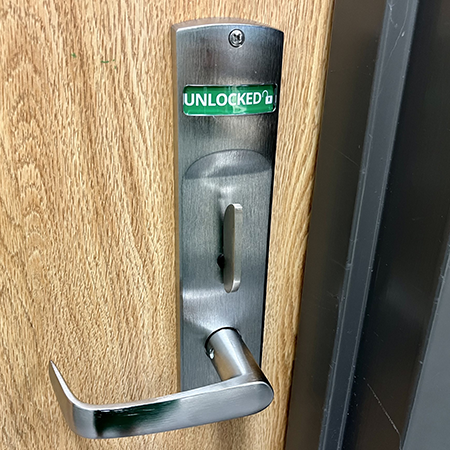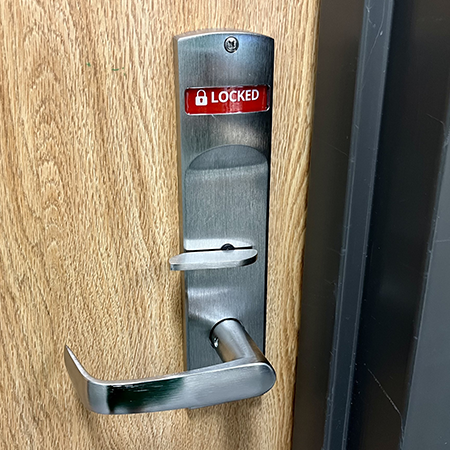
We all play a role in keeping our community safe. If you see something suspicious, report that crime using the contact methods on this website; or by texting MSUDPPS to CRIMES (274637) along with your message. You can also call our tip line at 844-99-MSUPD (844-996-7873). Be sure to also review SafeMSU Emergency Preparedness Guidelines posted in classrooms and facility lobbies.
- Remain vigilant and reduce distractions such as using a cell phone or digital devices
- Familiarize yourself with campus to know the quickest way to get help
- Take extra precaution at night by walking with a friend or group of friends
Evacuation
In the event of a fire, hazardous material spill, or power outage, an evacuation may be necessary. Each individual should:
- Proceed to the nearest exit
- Avoid all elevators and utilize stairs instead
- Move far away from the building. When possible, stay with your class/group to keep everybody accounted for
Preparedness Actions to Take:
- Familiarize yourself with exits at facilities you frequent
- Consider evacuation plans for those with functional needs. If someone is unable to evacuate, 911 must be notified of their location immediately
Shelter and Secure
Hazardous weather or hazardous material outside may occur and emergency sirens may be activated. If emergency sirens/warnings are activated/issued, individuals should:
- Stop all activities
- Check the current MSU Alert Status
- Shelter if necessary
Seeking Shelter: This refers to seeking an inside space until further notice. Shut all doors and stay away from exterior windows. Examples of shelter-in-place areas include large storage closets, break rooms, utility rooms, bathrooms without exterior windows, and basements.
Hazardous Weather: The most common hazardous weather that is prevalent in Michigan includes tornadoes, severe thunderstorms, flooding, and winter weather. In all of these circumstances, a shelter-in-place notification or siren could be sounded where seeking shelter would then be necessary until an all clear is given.
Hazardous Materials Outside: If there is a presence of hazardous material outside, a shelter-in-place warning may be issued. Actions to take in this situation include:
- Closing doors and windows in your selected shelter area
- Turn off fans and/or air conditioner
- If possible, have the building heating, ventilation and cooling (HVAC) turned off
- Use plastic sheeting, duct tape, towels, or clothes to seal windows, doors, air vents etc.
- Notify emergency services of your shelter location and the number of persons sheltered
- Monitor commercial radio/TV for an all-clear notice
- Remain in shelter until notified that conditions are safe to exit
Active Violence Incident Guidance
According to MSU Police, active violence is considered an “ongoing assault with a weapon." If an active violence incident occurs, everyone must take primary responsibility for their own personal safety. You should stay aware of your surroundings and minimize and decrease distractions such as cell phones, ear buds, or other items that could reduce your recognition of an incident or threat.
If you receive an MSU Alert or hear the alert tones outside, inform others and take a moment to figure out what is happening. You should also know your options. It is important to mentally and physically rehearse what you would do during an active violence incident to avoid freezing. The Run, Hide, Fight or Avoid, Barricade, Confront models can help you respond.
Run/Avoid
The first thing you should consider doing if an active violence incident is taking place is run, if you can do so safely. If you are not in the immediate vicinity of danger, avoid the area and notify others to do the same. Those physically unable to leave quickly should find a safe location to hide. Remember, seconds matter. Do not grab your personal items or pull a fire alarm, which may cause undue panic and divert first responder resources to the wrong location. Call or text 911 once you are safely away from the danger.
Hide/Barricade
If you are unable to run or avoid the area, you should hide and barricade. Barricade the doors with any items you can find. Improvise in this situation: tie off doors, pile up chairs, tables, bookshelves, or whatever else is in the area. Anything can potentially be used to barricade. Remember to conceal your presence. Lock the doors, draw the blinds, and stay out of sight away from windows and doors.
Fight/Confront
If the suspect enters your area, it is very likely that you will need to defend yourself. A pre-determined survival mindset will help you react quickly, which could help overwhelm the suspect and stop the attack. Commit to your actions. Work with others and use improvised weapons. Anything, such as chairs, fire extinguishers, backpacks, laptops, and scissors, can all be used as a potential weapon.
Active Violence Incident Awareness training for MSU students, faculty, and staff is available on MSU's Ability Training platform. In addition, an Active Violence Incident Awareness training video is available for anyone to watch on MSU DPPS's YouTube channel.
Only invite people you know to your on- or off-campus home. Don’t allow others to follow behind you to gain access to your residence.
Get to know your neighbors and look out for one another. If you see or hear something harmful and you live on campus, tell your RA and call MSU Police and Public Safety at 517-355-2221. For those living off-campus, notify your local police department. For emergencies, call or text 9-1-1.
Secure your belongings in public spaces, including lounges and laundry rooms.
Lock it or Lose it:
- Never leave your personal property unattended
- Before leaving your residence or vehicle, remember to lock the doors
- Remember to lock your door and windows before going to sleep
- Always lock your bicycle to a bike rack using a U-Lock through the frame and tire
It's important to note that residence hall living wings are securely locked 24 hours a day, 7 days a week. Access to living wings and elevators, as well as building entrances outside of regular hours, requires a valid MSU ID card. Residence halls lacking dining facilities, classrooms, or office spaces remain locked 24/7 to maintain a safe and protected environment for all residents. More information can be found on the MSU Live On website.
MSU Infrastructure Planning and Facilities has completed their work to install hundreds of new door locks for classrooms and teaching lab spaces across campus. These new locks allow those inside the classroom to lock the door while still allowing emergency personnel the ability to enter.
There are two main types of locks being installed across campus in classrooms and teaching labs:
1. Lockdown buttons: When a lockdown button is pushed, doors will electronically lock. Doors must be closed for the locking feature to work and emergency personnel will automatically be notified. With these locks, used mainly in larger auditorium-style classrooms with multiple entrances and exits, signage with directions is being posted next to the button.

2. Thumb-turn locks: Doors with handles that are locked by turning a "thumb-turn" on the inside of the door.


Regardless of lock type, those inside a classroom or teaching lab will always have the ability to leave the room. Faculty, students and staff should only lock their classrooms and teaching labs during an emergency presenting a threat of active violence. It is not required to keep doors closed and locked at all times.
- Use complex passwords that are changed frequently
- Do not open emails or links from untrusted senders
- Do not leave devices unattended
- Only shop online from known companies
- If you think your laptop has been infected with malware, contact police and the manufacturer - you might be at risk for identity theft
For more information, visit the MSU SecureIT website.
Indoor Safety
- Keep windows closed. Leaving them open, even for a short period of time, can damage pipes and heating systems. Doors and blinds should also stay closed to keep warm air inside.
Outdoor Safety
- Dress warm. Wear layers of loose-fitting, lightweight, warm clothing.
- Always wear a coat, mittens or gloves, and a hat.
- Cover your mouth to protect your lungs from extreme cold.
- Keep an eye out for slippery conditions, both indoors and out.
Travel Safety
- Don't travel if it isn't necessary.
- Carefully plan trips and avoid being outside for extended periods of time.
- Be aware of slippery road conditions and limited visibility. Even after crews have been out, there may still be patches of ice/snow on the roads and sidewalks.
- Drivers and pedestrians should give themselves extra time when traveling throughout campus.
- Pedestrians are encouraged to make eye contact with drivers before entering the roadway and know that it may take vehicles significantly more time to stop in snowy, wet, or icy conditions.
- If on campus, don't park in residence hall loops. MSU Infrastructure Planning and Facilities needs these areas clear for snow plowing.
- Faculty and staff should park university and personal vehicles in parking structures, if possible, to make it easier for surface lots to be cleared of snow.
For more information on winter weather safety, visit ready.gov/winter-ready.
Most buildings on campus have established an Emergency Action Team (EAT), consisting of members of that building who have received direct training on how to advise and assist during an emergency.
Building Coordinator
Most buildings have a designated EAT building coordinator, who is responsible for:
- Maintaining the building’s team
- Maintenance of the buildings EAP (Emergency Action Plan) disseminating information to other EAT members and building occupants providing training for building occupants
- Serving as a communication link between first responders and EAT members during an emergency
Unit Coordinator
For buildings that house multiple units, each unit has a designated unit coordinator, who may also serve as the primary or backup building coordinator. Unit coordinators are responsible for:
- Assisting the building coordinator in maintaining the building’s team and the building’s EAP assisting with training building occupants
- Disseminating information throughout their unit
EAT Leaders
All other EAT members represent their floor/wing/unit and are trained to advise and assist during an emergency.
Evacuation Emergencies
For emergencies requiring a building evacuation, EAT members may have additional responsibilities outside of advising and assisting others as they exit the building. Each building has designated rally points outside of the building, where occupants must gather upon evacuating, to be accounted for.
Each rally point will have at least one EAT member to serve as the rally point leader, who will collect information from other EAT members and building occupants and pass that information up to unit or building coordinators who will then connect with first responders to ensure that information gets to them if necessary.
Each exit door should have at least one EAT member assigned to assist in providing directions to those evacuating the building toward the rally point, and to ensure others do not enter the building until it has been deemed safe.
Seek Shelter Emergencies
For weather-related events that require building occupants to seek shelter, EAT members are responsible for informing others of the nature of the emergency and guiding them to a safe location until the emergency has ended.
Other Emergencies
For most other emergencies, all EAT members are trained to advise and assist others within the building while ensuring they do not compromise their own safety.
What EAT Members Are Not
Emergency Action Team members are not liable for others' safety; they are only trained to advise and assist. They are not responsible for ensuring others get to safety, only that information about an emergency and guidelines on how to respond are provided in a timely manner. Each person is responsible for their own personal safety and should not solely rely on EAT members in an emergency. EAT members are never expected to compromise their own safety while responding to an emergency.
For More Information
Please email em@dpps.msu.edu for questions regarding the Emergency Action Teams, or for a specific building contacts.